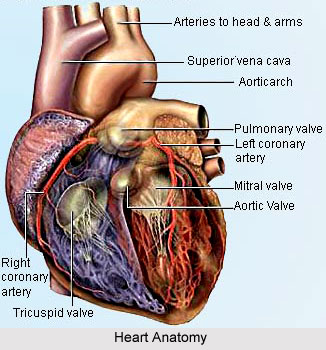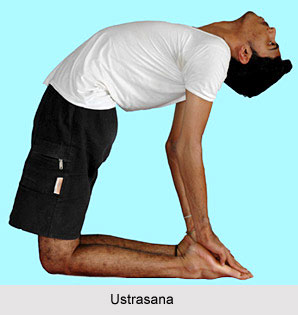 The heart is an indispensable, muscular organ in all vertebrates, responsible for pumping blood through the blood vessels by repeated, rhythmic contraction. The term cardiac means "related to the heart". The heart of a vertebrate is composed of cardiac muscle, an involuntary striated muscle tissue that is found only within this organ. The average human heart usually beats at 72 beats per minute.
The heart is an indispensable, muscular organ in all vertebrates, responsible for pumping blood through the blood vessels by repeated, rhythmic contraction. The term cardiac means "related to the heart". The heart of a vertebrate is composed of cardiac muscle, an involuntary striated muscle tissue that is found only within this organ. The average human heart usually beats at 72 beats per minute.
Heart diseases are widespread problem in today`s world. These heart diseases are usually psychosomatic in nature. Improper lifestyle, faulty diet and negative thinking play an important part in triggering heart disease. The thoughts, feelings and emotions affect the body and mind. Regular practice of Yoga can alleviate most of the heart problems. Coronary Heart disease means suffering of heart muscles due to short supply of oxygen. It occurs when arteries contracts by plaques (semi solid emulsion of LDP and calcium). With this constrained passage for oxygen rich blood, heart needs to pump more, further straining itself. Hypertension, smoking, and high cholesterol all contribute to this condition and in turn, these diseases develop over a long time. Since it is a long process, people miss the important symptoms till they are around 50 years of age. Chest pain (angina) and short breaths usually indicate heart disease. Men and women of both ages can be affected by heart diseases. But usually men are at risk after age 45 and women after 55 years of age (post menopause). Controlled yoga combining calming and stimulating measures resulted in reduced serum cholesterol and triglyceride levels. The concept of yoga for heart disease dates back to a long period. Of late, it is getting better coinage following by studies.
Some of the important Yoga asanas for healthy heart is as follows -
•Kapalabhati breathing is a pranayama technique that requires breathing in rapid succession while consciously controlling the movements of the diaphragm (a membrane separating abdomen from chest.) This exercises the entire respiratory system forcing higher oxygen absorption in a short time. This asana ensures richer blood to reach cardiovascular muscles regardless of its quantity, thus removing the major problem.
•Tadasana is a completely balanced standing posture and is the foundation for all asanas, which start from standing. One should touch the heels and big toes to each other with weight balanced evenly on metatarsals and toes spread. This asana stiffens and pulls-up calf muscles, kneecaps, thighs and hips.
•Shalabhasana or the locust pose is good for heart. The shalabhasana has many benefits. Strengthening the muscles of the upper legs and lower back and stimulating the stomach and intestines helps to relieve gastrointestinal gas, strengthens the bladder, and also stretches the spine.
•Bitilasana or the cow pose is essential to keep heart fit. This asana brings about a great stretch for the torso and back and an awakening of the spine. The tension is released from the stomach and groins.
•Ustrasana stretches the front of the body including the chest, abdomen, and quadriceps. It also improves spinal flexibility.
 A complete yoga program for the heart involves exercises (Asanas), breath control (Pranayama), sleep control (Yoga Nidra) and mind control (Meditation). These are the tenets for cardiac health; also probably the reason why cardiologists universally, recommend yoga to their patients. The curative benefits of yoga enhances heart health, lowers blood pressure, reduces chronic stress, boosts the immune system and enhances cognitive ability. However, Yoga also lays emphasis on four aspects that have a direct bearing on health. Achaar (character and conduct), Vichaar (perception or outlook), Vyayahaar (the way we behave) and Ahaar (diet or the food we eat). Any imbalance in any of these aspects shall result in disharmony of body, mind and soul and thus pave the way for various heart related diseases.
A complete yoga program for the heart involves exercises (Asanas), breath control (Pranayama), sleep control (Yoga Nidra) and mind control (Meditation). These are the tenets for cardiac health; also probably the reason why cardiologists universally, recommend yoga to their patients. The curative benefits of yoga enhances heart health, lowers blood pressure, reduces chronic stress, boosts the immune system and enhances cognitive ability. However, Yoga also lays emphasis on four aspects that have a direct bearing on health. Achaar (character and conduct), Vichaar (perception or outlook), Vyayahaar (the way we behave) and Ahaar (diet or the food we eat). Any imbalance in any of these aspects shall result in disharmony of body, mind and soul and thus pave the way for various heart related diseases.
Yoga contributes immensely in offsetting arteriosclerosis or the coronary artery blockage due to the deposition of fats on the inner walls of the heart. Thus, owing to its many positive effects direct and indirect on the cardiovascular system, yoga plays a pivotal role in heart care. Relaxation through yoga may help some patients control their blood pressure as well. Yoga may also improve the blood flow and make arteries and veins more elastic. Most of the Yoga poses and breathing techniques are useful in managing cardiovascular health. Yoga Nidra, Sun Salutation, Savasana are the important Yoga postures for heart ailments. A deep breathing exercise such as Ujjayi Pranayama is also helpful for cardiovascular health.
Yoga is an alternative system of healing, its power being widely harnessed to prevent and treat various diseases of the heart. Yoga is indisputably a reliable therapy for holistic health. Yogic way of life offers a solution to elevate the health of body, mind and soul. Yoga can cure most of the heart diseases and plays an important role in the prevention of cardiovascular diseases that includes recurrence of heart attacks, hypertension and coronary heart diseases. Yoga directly influences the hypothalamus, the area of the brain that controls the endocrine activity, and helps to prevent heart attacks.
DISCLAIMER - The Yoga asanas prescribed above should be strictly performed under the supervision of an experienced Yoga teacher.



